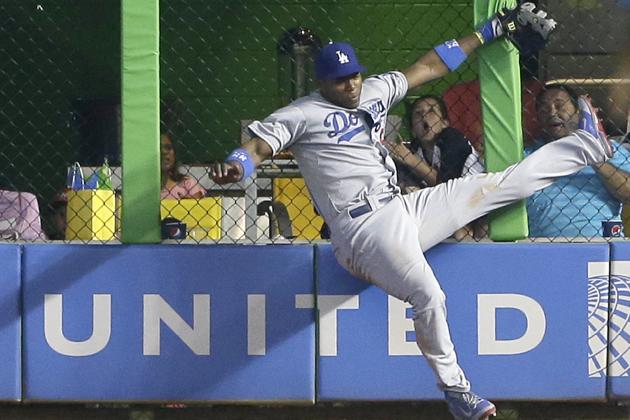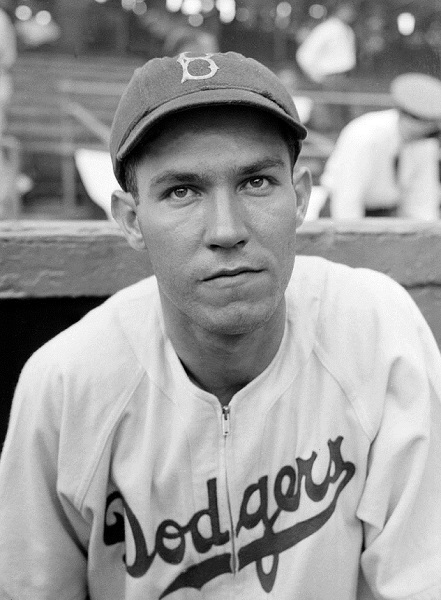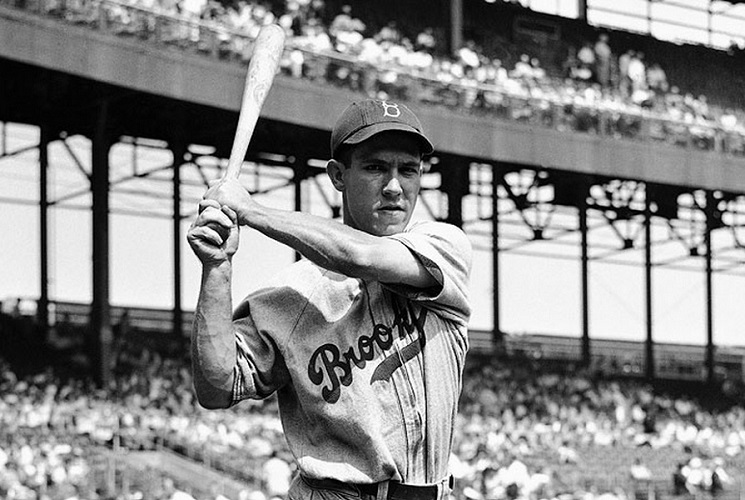Pete Reiser has not been a Dodger for 66 years yet he remains part of Dodger lore and thoughts of what might have been. His name is often brought up when Bryce Harper or Yasiel Piug are running into walls going all out to track down a a long fly ball.
Harold Patrick Reiser was born on March 17 in 1919 in St. Louis, Missouri, only months before the end of World War I in November. Born on St. Patrick’s Day, he gained his middle name. As a youngster he loved westerns and was often seen packing his pair of toy six-shooters in their holsters. In time he gained his nickname -”Pistol Pete”. Perhaps the twin pistols had something to do with his later ability to use either hand equally well.
His father, George Reiser, had been a pitcher in the Trolley League in St Louis with a reputation of being a good semipro pitcher. At an early age he began to throw to Pete and took no mercy on him. It turns out Pete, even as a youngster, didn’t need any mercy from his father, He could send them back so he already had a start in hitting well above his age class. As good as he turned out to be, he credits his brother Mike as being the true athlete in the family. Mike was signed by the New York Yankees but sadly for his family he contracted Scarlet Fever and died from his illness.
Growing up Pete Reiser excelled at any sport he tried. Besides baseball he earned $50 a game playing soccer against professional players and was a talented football player with a dream of becoming a star player with Notre Dame. He was a skillful bowler and proficient at ice skating. Perhaps his greatest strength was that he was truly ambidextrous.
As a 15 year old Pistol Pete, uninvited, made his way into a St. Louis Cardinal tryout. Needless to say he drew considerable attention and also presented a major problem for Branch Rickey, the Cardinals’ general manager. He out threw and out ran more than 800 other boys at the tryout, all older than him. That was the problem. He was too young to sign to a contract. Rickey did everything he could to keep the young Reiser away from the attention of the cross-town St. Louis Browns.
His plans to keep him out of sight worked and in 1937 Rickey was able to sign the 18 year old Reiser as a shortstop. He was not a big player at 5’ 11” but simply had it all – a powerful arm, a live bat, a discerning eye at the plate, the best speed in the game, and he was unrelenting on defense. Pistol Pete Reiser truly believed there was no ball to which he could not get. That later turned out to be a major challenge for him when he became an outfielder with the playing area confined by high, hard walls.
Only one year later Commissioner Kenesaw M. Landis, who did not approve of Branch Rickey’s farm system, simply declared 73 St. Louis farm players free agents. Pete Reiser was among that group and the Dodgers signed him for a $100 bonus after Rickey asked a favor of Dodgers president Larry MacPhail. The favor – sign Reiser, hide him in the lower minors and in due course trade him back to the Cardinals.
Once the Dodgers saw Reiser in only eleven at bats in the spring of 1939 that plan was scrapped. Reiser reached base in all eleven trips to the plate. Larry McPhail and Branch Rickey were no longer on such friendly terms as McPhail didn’t honor the deal which was illegal in any event.
The Dodgers assigned Reiser to Elmira in the Eastern League. Unfortunately bone chips in his throwing arm required surgery to correct and he missed most of the season. Even more unfortunate perhaps, the surgery necessitated a change in position from shortstop to the outfield.
Reiser was no longer a hidden gem. Before he had played a game in the majors, the Yankees offered $100,000 and five players for him. Larry MacPhail rejected the offer and returned Reiser to Elmira in 1940. On July 23, 1940 he was called up from the Class D Elmira team and played 58 games with the Dodgers enjoying moderate success.
By 1941 the fans had already fallen in love with Pete Reiser and his style of all out play. The 1941 season was to become one of the best seasons ever by a 22 year. Reiser finished the year with a .343 average to win the batting crown by a wide margin. He led the National League with thirty-nine doubles, seventeen triples, 117 runs scored, and a .558 slugging percentage, and finished second to teammate Dolph Camilli in voting for the Most Valuable Player award. His OBP was .406.
The Brooklyn faithful knew that Reiser was a special player but what happened next they could not have imagined. Mark Stewart from the Society For American Baseball Research describes that fateful day in the lives of the Dodger fans and in the life of Pistol Pete Reiser: “On July 18, 1942 he raced toward the center-field wall, narrowly avoiding the flagpole that rose from the playing field, and caught Enos Slaughter’s hit in full stride—and then hit the concrete wall an instant later. The ball fell from his glove and, although dazed, he threw the ball to cutoff man and future Hall of Famer Pee Wee Reese. By the time Reese fired the ball home, Slaughter had circled the bases to win the game.
Pete Reiser lay on the field motionless, facing the sky, his shoulder separated and blood trickling from his ears. When Durocher reached him, the manager started to cry. Pete was carried off on a stretcher and woke up the next morning in the hospital with a fractured skull and a brain injury. The Cardinals’ team doctor examined him and recommended that he not return to the field that season. In the era before the effects of a concussion were fully understood, Reiser did what gamers do—he returned to the diamond as soon as he could walk. He was dizzy, had a hard time focusing, and felt weak, but there was no keeping him out of the lineup.”
Reiser served in the military from 1943 through 1945. He was unable to pass the physical for active duty but was able to enlist because he could play baseball. It was during this time that Reiser first saw his future teammate Jackie Robinson. “One day a Negro lieutenant came out for the ball team,” he explained to Donald Honig. “An officer told him he couldn’t play. ‘You have to play with the colored team,’ the officer said. That was a joke. There was no colored team. The lieutenant didn’t say anything. He stood there for a while, watching us work out. Then he turned and walked away. I didn’t know who he was then, but that was the first time I saw Jackie Robinson. I can still remember him walking away by himself.”
After serving in the military, Reiser returned to major league baseball playing three years with the Dodgers, two with the Boston Braves, one with the Pittsburgh Pirates and his last with the Cleveland Indians. However following his accident in 1942 he would never be even close to the same player that he had been before that day. He played only four full seasons of major league baseball with his performance statistics and games played declining each year. His career statistics: .295 BA in 861 games, 473 runs scored, .380 OBP and 87 stolen bases.
One report is that among his numerous injuries Reiser was carried off the field on a stretcher eleven times during his career. He did stay in the game as a minor league manager with the Dodgers for some time and in 1957 was coaching with Kokomo of the Class D Midwest League. While there he took a homesick Tommy Davis under his wing encouraging him to be aggressive at the plate and on the bases. “Pete Reiser made a man of me,” said Davis.

Yasiel Puig plays with the same intensity and fearlessness that Pete Reiser did almost 75 years ago.
(Photo credit – Wilfredo Lee)
How good was Pistol Pete Reiser or how good could he have become? Leo Durocher said in his autobiography Nice Guys Finish Last: “There will never be a ballplayer as good as Willie Mays, but Reiser was every bit as good, and he might have been better. Pete Reiser might have been the best ballplayer I ever saw. He had more power than Willie. He could throw as good as Willie. Mays was fast, but Reiser was faster. Name whoever you want to, and Pete Reiser was faster. Willie Mays had everything. Pete Reiser had everything but luck.”
Pete Reiser’s is a story of what might have been. However, he never regretted the way he played declaring it had to be:“If I hadn’t played that way I wouldn’t even have been whatever I was. God gave me those legs and the speed, and when they took me into the walls that’s the way it had to be.”
Pistol Pete Reiser passed away on October 25, 1981 in Palm Springs, California, following a long respiratory illness. He was just 62.




 May 24th, 2014 at 6:00 am
May 24th, 2014 at 6:00 am  by Harold Uhlman
by Harold Uhlman 

 Posted in
Posted in 

Interesting stuff, Harold. Thanks.
It’s amazing how many players’ careers have turned drastically after an injury. I always think of Jason Repko who, after seriously spraining his ankle trying in vain to catch a home run ball that he never had a chance for, was never the same and eventually let go.
There are others, though, who were able to come back and have great careers such as Jayson Werth and, of course, Tommy John.
As I’ve said many times, baseball waits for no man – an untimely injury could cause the game to simply pass you by.
In Pete Reiser’s case, you have to wonder if his very serious concussion affected the rest of his career, although he seemed to continued to play with reckless abandon even after that serious injury – kind of like that other guy we know and love.
I think the bone chip surgery that caused him to become an outfielder helped derail his career more quickly than if he had remained an infielder.
His 1941 year as a 22 year old was just an amazing year.
Another great article Harold
I was lucky to be a Dodger fan while Reiser was still playing for them. He of course was not the caliber of player he was before that time but I remember that he was still a popular player and I was told of his former escapades. Yes,he was known for his reckless play and running into walls.
I believe that Reese and Reiser were for some reason known as the “Gold dust Twins”. I can’t remember why? Maybe some one can let me know more about this.
Not sure OBF. Both were rookies at the same time, gold type players, roommates and both with an odd first name – Harold. I expect it had to do with the quality of their play.
Great article, Harold. I really enjoyed reading it. Of course I knew about Pete Reiser running into the wall and the serious injury he suffered, but I didn’t know a lot of the other details you brought up. He was truly a unique person and player. It’s a shame his career was cut short.